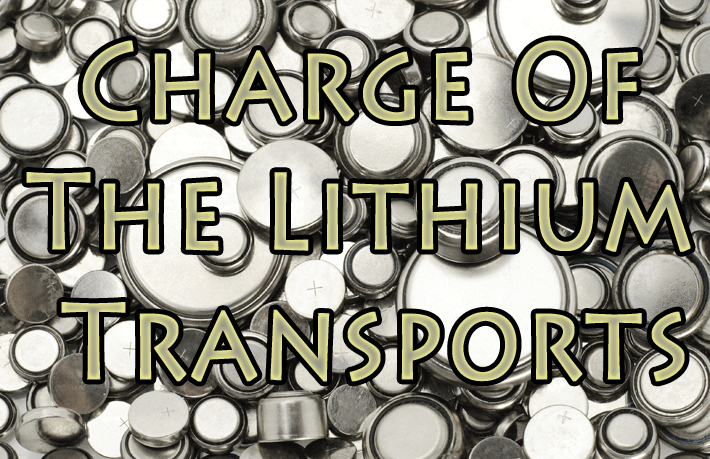
As we continue our exclusive, in-depth coverage of the never-ending story of Lithium Batteries and air cargo, it should be noted that as recently as last week, FT wrote about the ICAO DGP's decision to essentially not introduce further limitations regarding the transport of lithium batteries.
Although the joint paper presented by ICCAIA and IFALPA was rebuffed out of hand, other measures have been adopted.
That has left some people up in the air with the current state of regulations.
One main rule change that was approved by the ICAO panel concerns the SOC, or “State Of Charge,” meaning how much power can be packed into a Lithium-Ion battery prior to transport.
Currently, the regulations do not limit the state of charge either way, but that is going to change—most likely effective next April 1, 2016.
SOC It To Me?
While it is an established fact that the SOC (State Of Charge) has an effect on the danger presented by Lithium-Ion and Lithium Polymer batteries in transport, the bottom line of how much charge per unit is acceptable seems to vary greatly depending on the exact chemistry of the battery.
For example, a great number of different battery technologies—or battery chemistries—fall under the classification of Lithium-Ion and Lithium Polymer battery, UN 3480.
The reader should note that terms such as “seem to” and “presumably” have been employed here not for want of sufficient research, but because there are many open questions and uncertainties relating to the SOC.
The 30% Factor
One thing, however, is agreed upon, and that is that “one size fits all” solutions do not exist when it comes to Lithium batteries solutions.
In other words, while for some battery technologies the upcoming SOC limitation is 30 percent, for other manufacturers and shippers, limiting the SOC to 30 percent has a detrimental effect on the shelf life.
In layman’s terms, while the “ideal” SOC varies depending on battery type and technology, it usually is indicated between 40 percent and 65 percent. Reducing or exceeding the SOC may also reduce the shelf life of these batteries, e.g. batteries stored for extended periods of time at a SOC of less than the recommended value may become unusable or at least will have their lifespan drastically reduced.
Different Strokes
When it comes to SOC in a lithium battery, in a typical usage cycle a computer laptop battery, for example, may be depleted after two hours instead of five and/or become unusable after six months (instead of two years).
No Checkpoints
Another important point is that the SOC as a requirement next April will in reality be a rule that cannot be checked upon acceptance for shipping.
What that means is if during transit a consignment is involved in an incident or accident, the shipper will have to prove compliance with the 30 percent SOC requirement.
Taking The Heat
But getting a line on what has happened in an incident may be easier said than done, since the SOC seemingly—at least for some battery chemistries—depends on the ambient temperature.
Degrees of Safety
Firstly, Lithium batteries generally tend to exhibit poor performance in cold environments.
So shipment SOC probably will depend on ambient temperatures during the initial charge and transport.
One more question arising from this issue is that SDS, Safety Data Sheets, although not required for articles such as batteries (but often offered by manufacturers and shippers because of demands throughout the transport chain) limit the permissible ambient temperatures deemed “safe” for Lithium-Ion batteries to values outside of the temperature range indicated as “normal during air transport” within the IATA Dangerous Goods Regulations (-40 Degrees C to + 55 degrees C, subparagraph 5.0.4.1).
If an SDS limits the “safe” range to -40 to +50 degrees C, theoretically a transit through many airports would be a no-go since temperatures in cargo containers during a Middle Eastern transit scenario or many southern hemisphere tarmacs often reaches an excess of 50 degrees C.
Reality Check
Taking a momentary broader view reveals that Lithium shipments transiting airports are a fairly frequent scenario today and there have been no reports of heated batteries going up in flames, so maybe all these “what if” scenarios and other hasty conclusions are a bit premature.
Give One To PRBA
Given the lack of clear data surrounding the issue of SOC, it is hard to argue with PRBA’s comment that “PRBA believes it is premature to adopt a state-of-charge limit on lithium-ion cells and batteries, even as an interim measure.”
PRBA makes a convincing point here, especially given the aforementioned fact that shippers such as distributors of various electronics—like MP3-players and laptops—have no means at their disposal to verify the SOC in their Lithium battery shipments.
An IATA Secrecy Act?
After the voting within the ICAO DGP was leaked to AP and subsequent reports questioned IATA positioning itself against aircraft manufacturers, airline pilots, and the state exporting most of the batteries in question last month, IATA’s Global Head of Cargo Glyn Hughes was quoted, saying:
“IATA is concerned about the voting becoming public.
“Discussions, especially on safety, should be held behind closed doors.
“You need to keep the sanctity of meetings because people otherwise may feel that they have to vote a certain way.
‘The votes should be based on the facts that are presented,” Mr. Hughes said.
While Mr. Hughes is certainly right about the need to make fact-based decisions, it needs to be emphasized that the delegates at the ICAO DGP represent governments and organizations involved in the air transport chain.
That would also seem to include the responsibility that no voting connected to this all-hands-on-deck issue be conducted by secret ballot done behind closed doors:
“It needs to be pointed out to IATA,” a source told FT, “that most detrimental to the concept of safe transport of dangerous goods—by air and otherwise—is lack of facts and assumptions made on hearsay.
“Therefore, transparency in this issue is essential.
“Everyone should be allowed to know how the representative of any government voted—either for or against the joint ICCAIA/IFALPA initiative. It should not be kept secret.
“As a matter of fact, in times where lobbying by industry stakeholders and lobby organizations are under increased scrutiny, a more straightforward approach from IATA’s side might yield a more favorable response on the side of those stakeholders who haven’t revealed their opinion yet.”
Jens



